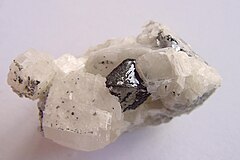Carrollite
| Carrollite | |
|---|---|

|
|
| General | |
| Category |
Sulfide mineral Thiospinel group (Spinel structural group) |
|
Formula (repeating unit) |
CuCo2S4 |
| Strunz classification | 2.DA.05 |
| Dana classification | 2.10.1.2 |
| Crystal system | Isometric |
| Crystal class | Hexoctahedral (m3m) H-M symbol: (4/m 3 2/m) |
| Space group | Fd3m |
| Identification | |
| Color | Light to dark gray, rarely tarnishes to copper red or violet gray |
| Crystal habit | Octahedral and cubic crystals, also massive, granular or compact |
| Twinning | {111} Polysynthetic or spinel twins |
| Cleavage | Imperfect on {001} |
| Fracture | Conchoidal, subconchoidal or uneven |
| Tenacity | Very brittle |
| Mohs scale hardness | 4.5 to 5.5 |
| Luster | Metallic |
| Streak | Grey black |
| Diaphaneity | Opaque. R is 43% to 45% for lambda = 560 nm |
| Specific gravity | 4.5 to 4.8 measured, 4.83 calculated |
| Refractive index | n is not determined for an opaque mineral |
| Solubility | Minerals of the linneite group are partly etched by nitric acid, with slight effervescence. |
| Other characteristics | Not radioactive, not fluorescent |
| References | |
Carrollite, CuCo2S4, is a sulfide of copper and cobalt, often with substantial substitution of nickel for the metal ions, and a member of the linnaeite group. It is named after the type locality in Carroll County, Maryland, US, at the Patapsco mine, Sykesville.
Space group: Fd3m. Unit cell parameters = a = 9.48 Å, Z = 8. Unit cell volume: V = 851.97 ų (calculated from unit cell parameters).
The linnaeite group is a group of sulfides and selenides with the general formula AB2X4 in which X is sulfur or selenium, A is divalent Fe, Ni, Co or Cu and B is trivalent Co, Ni or, for daubréelite, Cr. The minerals are isometric, space group Fd3m and isostructural with each other and with minerals of the spinel group.
The structure of the linnaeite group consists of a cubic close packed array of X (X is oxygen in the spinels and sulfur or selenium in the linnaeite group). Within the array of Xs there are two types of interstices, one type tetrahedrally co-ordinated and one type octahedrally co-ordinated. One eighth of the tetrahedal sites A are typically occupied by 2+ cations, and half of the octahedral sites B by 3+ cations. Charnock et al. confirmed that carrollite contains Cu wholly within the tetrahedral sites. Thus, the ideal formula one would expect for a spinel like carrollite is Cu2+Co3+2S2−4, but as in the case of copper sulfides in general the oxidation state of the copper atom is 1+, not 2+. An assignment of valences as Cu+Co3+2S1.75−4 is more appropriate; this was confirmed in a study of 2009. The one missing electron per four sulfur atoms is delocalized, leading to metallic conductivity and even superconductivity at very low temperatures, combined with a complicated magnetic behavior.
...
Wikipedia
